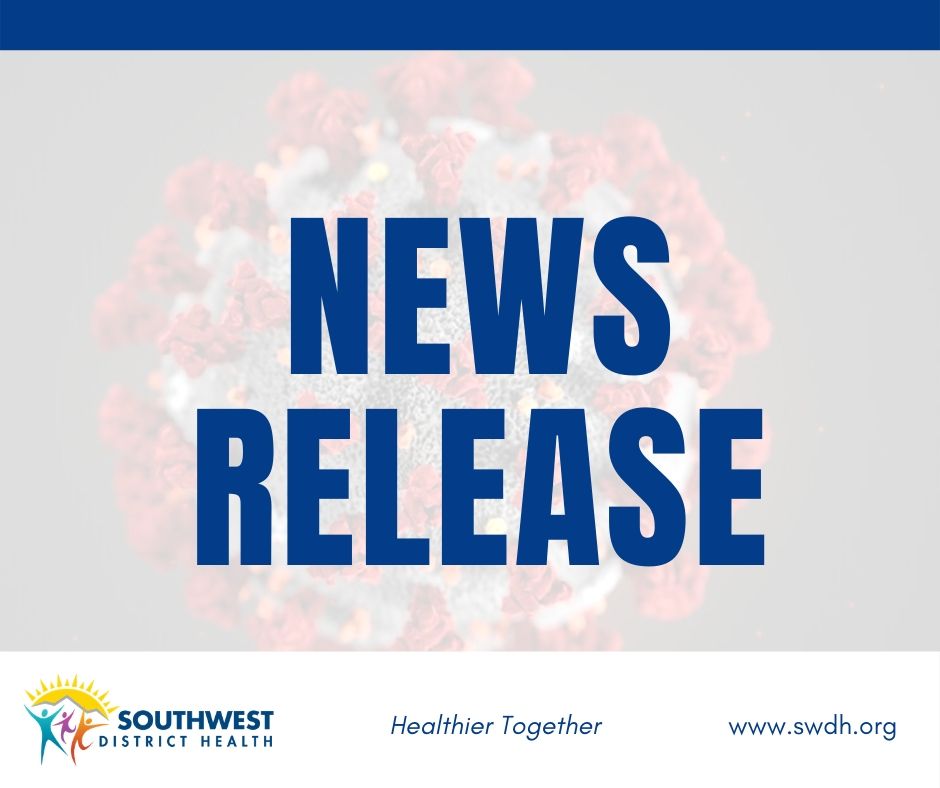First Case of Mpox (formerly Monkeypox) Reported in Canyon County
FOR IMMEDIATE RELEASE
November 21, 2023
CALDWELL, IDAHO – Southwest District Health (SWDH) is announcing the first case of mpox (formerly known as monkeypox) in its jurisdiction. The case was detected mid-November in a man who lives in Canyon County.
The investigation is ongoing. Epidemiologists have not yet been able to determine the source of the exposure, but there is currently a small outbreak in Ada County. Local and state public health officials are working with the patient to make sure any potential close contacts are identified and notified of exposure risk, and the patient’s healthcare providers to ensure the patient is treated, if need be.
Mpox can be mild to severe. Most people with mild mpox disease recover on their own. Antivirals are available for patients who might have severe disease, have other conditions that might increase their risk for severe disease, or develop complications. Southwest District Health recommends vaccination for people who have been exposed to mpox or might be exposed to mpox to reduce symptoms and prevent further spread in our community. Southwest District Health is able to provide the JYNNEOS (pronounced gin-EE-ohs) vaccine to those who are looking to get vaccinated or have been recently exposed. Residents can call Southwest District Health at 208-455-5300 to schedule an appointment. Individuals with mpox should self-isolate until their lesions have fully healed with new skin where the lesions used to be. Residents can contact their local health district if they have any questions or concerns about isolating.
How is mpox spread?
Mpox can spread to anyone through close, personal, often skin-to-skin contact, including:
- Direct contact with mpox rash, scabs, or body fluids from a person with mpox. We believe this is currently the most common way that mpox is spreading in the U.S.
- Touching objects, fabrics (clothing, bedding, or towels), and surfaces that have been used by someone with mpox.
- Contact with respiratory secretions.
What are the symptoms of mpox?
Symptoms* of concern include:
- Fever ≥100.4°F (38°C)
- Chills
- Swelling of the lymph nodes
- New skin rash – Rash may look like pimples or blisters.
*Fever and rash occur in nearly all people infected with mpox virus.
Close contacts should be monitored for symptoms for 21 days after their last exposure. If symptoms develop, individuals should isolate and call Southwest District Health for further guidance. Contacts who remain asymptomatic can continue routine daily activities.
How to prevent mpox?
Take the following steps to prevent mpox:
- Avoid close, skin-to-skin contact with people who have a rash that looks like mpox.
- Do not touch the rash or scabs of a person with mpox.
- Do not kiss, hug, cuddle or have sex with someone with mpox.
- Do not share eating utensils or cups with a person with mpox.
- Do not handle or touch the bedding, towels, or clothing of a person with mpox.
- Wash your hands often with soap and water or use an alcohol-based hand sanitizer.
What to do if you have symptoms of mpox?
SWDH encourages anyone who is experiencing an unexplained skin rash with or without a fever to contact their healthcare provider and avoid contact with others. If possible, call ahead before going to a healthcare facility. If you are not able to call ahead, tell a staff member as soon as you arrive that you are concerned about mpox. Tell your doctor if in the month before developing symptoms:
- You had contact with a person who might have had mpox.
- You were in an area where mpox has been reported (currently, Europe, North America, South America, Australia) or in an area where mpox is more commonly found (the Democratic Republic of the Congo, Republic of the Congo, Nigeria, Central African Republic, Cameroon, Côte d’Ivoire, Gabon, Liberia, Sierra Leone, Sudan).
Anyone who is ill with these symptoms is encouraged to follow advice given by SWDH and their healthcare provider to help prevent the spread to others.
For more information on mpox, please visit www.cdc.gov/poxvirus/mpox/symptoms.
####
ABOUT
Southwest District Health is one of seven public health districts throughout Idaho established to protect and promote the health and wellness of those who live, work, and play in our region. We proudly serve Adams, Canyon, Gem, Owyhee, Payette and Washington Counties. We work in partnership with our community to identify health needs, design solutions, and implement services that encourage behaviors contributing to healthier, longer lives. Learn more at www.swdh.org.
###
Media Contacts:
Monique Evancic, Public Information Officer
Southwest District Health
Monique.Evancic@phd3.idaho.gov
208-800-1262
